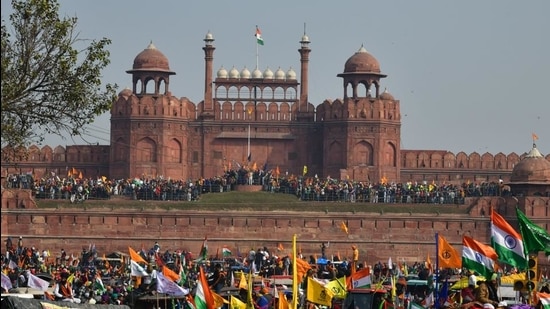What went wrong on Republic Day?
Farm leaders overestimated their ability to control a large and diverse group, while Delhi Police underestimated the scale of the rally
It was meant to be the moment in the sun for Indian farmers. After two months of protesting in the freezing winter cold, this was a chance to celebrate their identity in a truly unique manner. The tractor was the farmers’ badge of pride, their version of the mighty tanks that would roll down Rajpath on Republic Day. As one of them, furiously waving the tricolour, told us: If jawans can march at Rajpath, why can’t we kisans also have our tractor parade? Every jawan is after all also a kisan!”

It didn’t take long for the reverie to be shaken. By forenoon, it was clear that there were a section of the farmers who had turned a potentially momentous occasion into a recipe for violent confrontation. Breaking police barricades, changing the agreed route, and heading straight towards central Delhi, the farmer-protester was now transformed into an ugly street thug.
It wasn’t as if every farmer was part of the mob. There were enough farmers who, dressed in their colourful shirts and striking headgear, were still determined to make this a joyful occasion. Some were being showered with flowers along the route even as others more menacingly wielded lathis and swords. Whereas some adhered to the great Sikh tradition of offering langar food to those passing by, others were driving their tractors straight at the police pickets.
So why would farmer groups, all seemingly driven by the same goal of a repeal in farm laws, react so differently? Why did some groups turn rogue, break all rules, eventually pushing their way into the hallowed Red Fort area? Only a transparent inquiry will reveal the truth, but it is increasingly apparent that to treat farm protestors as a monolithic entity which would act in perfect unison was always a misreading of the ground situation.
The farmers, after all, represent more than 30 small and large unions, different jathas, and come from varied groups across different regions. A call for repealing farm laws may have united them, but their political ideologies stretched across the spectrum. Like with any large movement, this was akin to a Shivji ki baarat, a real disparate gathering of just about anyone who wished to join the bandwagon. What, for example, did a psephologist-turned-activist neta like Yogendra Yadav have in common with actor, Sunny Deol groupie and a Khalistani sloganeer such as Deep Sidhu? Just where did a dyed-in-the-wool Leftist such as Hannan Mollah fit in with an aggressively ambitious political farm entrepreneur like Rakesh Tikait of the Bharatiya Kisan Union?
To have then expected thousands of tractors to conform to a rigid plan of action was always being unrealistic. Why the Delhi Police, despite their better judgment, allowed the political leadership to overrule their objections to a tractor rally of this magnitude is still a mystery. The Delhi Police, to its credit, acted with professionalism and showed extreme restraint in the face of grave provocation by an unruly mob. But facing the dual task of manning capital security and dealing with an unprecedented tractor rally, an over-stretched police force was out-numbered.
If the police perhaps underestimated the tractor rally, the farm leaders overestimated their ability to rein in such a large and diverse grouping. For two months, the farmers, quite remarkably, kept their peace, perhaps hoping that the sheer symbolism of their peaceful protest would force an all powerful Centre to relent. They almost succeeded — in the last week, it was apparent that the government was under pressure to concede to most of the farmer demands. Perhaps carried away with their success, farm unions overplayed their hand.
In a sense, farm leaders must accept moral responsibility for the violence that has de facto delegitimised their unique protest. This farm movement was driven by an ethical code until now, a wider public acceptance that the “kisan as anna-datta” (food provider) cannot be taken for granted. But the deeply troubling images of the protesters forcibly entering Red Fort, attacking the police at various places and threatening mediapersons have shaken the romantic illusion of the hardworking farmer as men and women of honour. By breaking the law, the tractor became a weapon of self-destruction.
The Centre, too, needs to course correct. For the longest time, the government has been trapped in hubris, a state of mind which views any street protest as “anti-national” and a challenge to its dominance. A directionless Opposition, too, has fished in troubled waters while piggybacking on the protests. Had there been greater trust and goodwill on all sides, there would have been less reason to push the agitation to breaking point.
Even now, it is not too late for a resolution if only this is not seen as a prestige issue.
For now, the violence has seriously dented the credibility of a protest movement that seemed genuine and spontaneous while the majesty of the Indian State has also taken a hit. Republic Day 2021 will go down as the day when the inspirational “Jai Jawan, Jai Kisan” slogan lost a bit of its sheen.
Post-script: The death of one farmer on January 26 when a tractor overturned while attempting to ram into a police barricade has made headlines and become a symbol of the anarchic few hours in central Delhi. But what of the 60-odd farmers who have died in the extreme cold during the protests over the last two months? Who will mourn for them?
Rajdeep Sardesai is a senior journalist and author
The views expressed are personal




